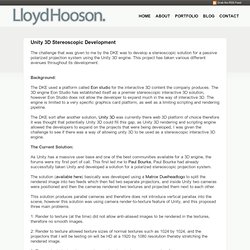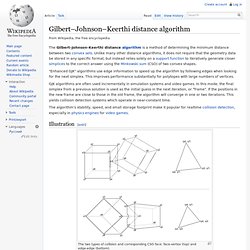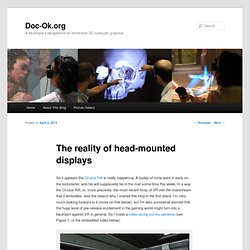

Lloyd Hooson 3D. The challenge that was given to me by the DKE was to develop a stereoscopic solution for a passive polarized projection system using the Unity 3D engine.

This project has taken various different avenues throughout its development. Background: The DKE used a platform called Eon studio for the interactive 3D content the company produces. The 3D engine Eon Studio has established itself as a premier stereoscopic interactive 3D solution, however Eon Studio does not allow the developer to expand much in the way of interactive 3D. The engine is limited to a very specific graphics card platform, as well as a limiting scripting and rendering pipeline. Www.digitaltskapande.se/sajt/wp-content/uploads/unitytutorial_room.pdf. Inglobe Technologies. 3D Theory - Collision Detect. To make sure that any area of space cannot be occupied by more than one object, then we need collision detection based on the geometry arrays of the objects. The big issue with collision detection is the number of tests that have to be made and therefore the CPU resources used.
For example if we have 'n' objects then the first object could collide with n-1 objects (since we don't check if an object has collided with itself) the second object could collide with (n-2) additional objects not counting the possible collisions we have already counted. If we keep going like this we get the number of possible collisions is: (n-1) * (n-2) * (n-3) ... 1 This is equivalent to n! During an animation we may need to check for collisions at every frame therefore it is important that collision detection is very efficient. Space Partitioning Bounding boxes However this only applies if the bounding boxes are axis aligned. Bounding spheres It is very easy to detect if bounding spheres overlap, for instance, A fast procedure for computing the distance between complex objects in three-dimensional space - Robotics and Automation [see also IEEE Transactions on Robotics and Automation], IEEE Journal of - gilbert.pdf.
Gilbert–Johnson–Keerthi distance algorithm. "Enhanced GJK" algorithms use edge information to speed up the algorithm by following edges when looking for the next simplex.

This improves performance substantially for polytopes with large numbers of vertices. GJK algorithms are often used incrementally in simulation systems and video games. In this mode, the final simplex from a previous solution is used as the initial guess in the next iteration, or "frame". Revolutionary virtual-holographic computing. VRLOGIC - Willkommen bei VRLOGIC ... VRLOGIC ist Ihr professioneller Partner im Bereich 3D-Technologie.

Innovative und ausgereifte Produkte sind unser Angebot. Eine qualifizierte Beratung und engagierte Services sind unser Anspruch. Auf Basis vertrauensvoller und exklusiver Beziehungen zu führenden Herstellern der Branche und unserem langjährigen,ausgeprägtem technischen Know-how bieten wir ausschließlich hochwertige Produkte und Lösungen an. Vor allem aber stehen Sie, unsere Kunden, mit Ihrem spezifischen Bedarf und Ihren individuellen Anforderungen im Mittelpunkt. Wir beraten Sie individuell und bieten Ihnen Full-Service-Leistungen, die Sie nicht nur überzeugen, sondern reell begeistern sollen: von aktuellsten technischen Möglichkeiten und unserem ganz persönlichen Engagement.
Messen & Events - Symposium IT Factory Innovation am 22.5.2014 von Uhr 9:00 bis 17:00 an der Hochschule SRH in Heidelberg Vielen Dank für Ihren Besuch auf der: - Learntec, Messe Karlsruhe vom 04.-06. Enhance your 3D learning experience. Amazing 3D immersion technology. Thanks to the good folks at WATG‘s Wimberly Labs, we got a tour today of some truly remarkable visualization and collaboration technology, including EON Reality‘s immersive 3D room.

The cave (or iCube, as we’re told they would prefer we call it) is comprised of three white walls and a floor, all about 10′ x 10′ in size. Onto each surface is projected a high-resolution, stereoscopic image. A viewer stands in the room wearing polarized 3D glasses — like you might use in a 3D movie — with small markers that stick out a bit from the frames. The markers are illuminated by IR LED floodlights located on the perimeter of the room, and IR-sensitive cameras use those positions to determine the precise location of each eye within the room.
From those positions, stereo images for each projector are calculated and rendered on the fly, and the result is absolutely amazing. We had heard about this technology before, but seeing is believing. The reality of head-mounted displays. So it appears the Oculus Rift is really happening.

A buddy of mine went in early on the kickstarter, and his will supposedly be in the mail some time this week. In a way the Oculus Rift, or, more precisely, the most recent foray of VR into the mainstream that it embodies, was the reason why I started this blog in the first place. I’m very much looking forward to it (more on that below), but I’m also somewhat worried that the huge level of pre-release excitement in the gaming world might turn into a backlash against VR in general.
So I made a video laying out my opinions (see Figure 1, or the embedded video below). Figure 1: Still from a video describing how head-mounted displays should be used to create convincing virtual worlds. Hidden Creative.